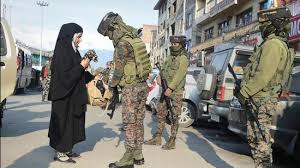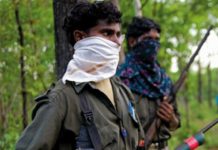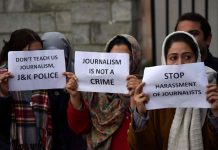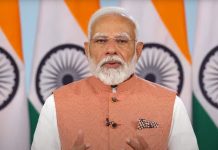Some observers feel that the centre may be reluctant to hold polls in the UT not just because of the renewed militancy in Jammu but also because of the prospect of the elected government asserting itself against the centre’s ongoing policies in the region. A report by Riyaz Wani

On August 5, as India observed the fifth anniversary of the abrogation of Article 370 that granted J&K its semi-autonomous status within India Union, the erstwhile state was largely indifferent to the occasion. In both Kashmir Valley and Jammu division, it was just another day for the ordinary people. There was some political activity though with the parties split in their support or opposition to the move.
The BJP organized the ‘Ekatma Mahotsav’ rally at Bana Singh Stadium in RS Pura in Jammu, to celebrate what it said “the complete integration of Jammu and Kashmir with India.” A similar rally was held by the party in Kashmir Valley.
On the other hand, several leaders of Jammu and Kashmir regional political parties, including former Chief Minister Mehbooba Mufti, accused the Lieutenant Governor’s administration of placing them under house arrest on the day.
The administration also beefed up security across the Union Territory. Extra security measures and checkpoints were put in place in Srinagar and Jammu, the twin capitals of J&K. The Amarnath yatra was halted in Jammu “as a precautionary measure”.
On the face of it, this didn’t make for a good advertisement for the union government’s achievements in J&K over the past five years. But it is also true that much has changed in the UT in this period. Kashmir Valley is no longer a witness to frequent protests, stone-pelting and shutdowns. Separatist politics has all but disappeared. Tourism is booming, with over one crore tourists having visited the union territory in the first six months of this year. Tourists are also visiting the hitherto no-go zones near the border with Pakistan.
But does this constitute normalcy? Apparently yes. But look deeper, and the situation appears contrary to its outward appearance. While mass protests may have vanished, the overall sense of uncertainty hasn’t. And if there has to be real peace in the Valley, the government will need to reach out to people to make them a part of the ongoing process rather than go about doing things without their consent.
The ongoing transformation is principally driven by the suppression of separatist politics, decline in militancy and the growth in tourism.
No space for separatist politics
The once-vaunted separatist conglomerate Hurriyat Conference has become extinct. Many of the grouping’s top leaders continue to be in jail or are under house arrest. This has hobbled its capacity to organize any political activity.
Although, chief of the moderate Hurriyat Mirwaiz Umar Farooq is largely free, the government continues to control his movements outside his home, including his Friday sermons at Srinagar’s Grand Mosque. This, despite the fact that he has stayed short of making any separatist sounding statements.
The government has outlawed any sign of separatist activity in whatever form and disproportionately raised the costs for any leader or an activist to go out and champion the cause. Top separatist leaders such as Yaseen Malik , Shabir Shah, Masarat Alam, Naeem Khan, Shahidul Islam and the others have been in jail since the abrogation of Article 370. This has had a chilling effect on the separatist politics in Kashmir Valley.
Administrative, legal changes
There have also been far-reaching administrative and legal changes right from the domicile laws to new land laws. As a result, J&K citizenship and the buying of land have been thrown open to outsiders. The government has also overturned the Roshni Act whereby occupants of state land were allowed to own it against payment determined by the government. Scores of other laws have been extended to the former state that is aiding the process of fundamentally altering the facts on the ground.
At the same time, the government has changed the electoral map of J&K by creating District Development Councils, a third tier of the grassroots democracy, whose members unlike in any other state in India are being directly elected. The DDCs are expected to not only undermine the role of the gram sabhas and the Block Development Councils – the first and second tier of Panchayati Raj respectively – but also detract from the powers of the Assembly. The 14-member DDC headed by a chairperson is largely in charge of the district. Their decisions override those of a panch, sarpanch, and a BDC member. Similarly, a future Member of Assembly despite being a member of the DDC will have no role in the election or removal of its chairperson.
Renewed challenge of militancy
Despite the conspicuous change in overall security situation, the region continues to grapple with the challenge of militancy. One such challenge has been the revival of militancy in Poonch and Rajouri districts of Jammu division.
More than a decade ago, the twin districts were declared free of militancy by the government. However, since October 2021, the region has witnessed a surge in militant attacks.
No doubt, an uneasy calm prevailed in Jammu in 2022, but this year the region has once again become a hotspot for militancy, with around 52 security personnel being killed in ambushes so far. This has raised concerns about the number of militants in the area. It is believed that the militants have infiltrated from across the border, although the exact number is unknown. The dense forests of the region have made it difficult for security forces to trace them. The situation has been made even more concerning by the fact that the forest area where the militants are hiding extends to Shopian in South Kashmir, the district that has been a hotbed of militancy in recent years.
One reason being offered for the growing militant activity in Jammu areas is the thinning of the presence of security forces in the region in the last two years, a fact being exploited by the militants. Two reasons are offered for this state of affairs: One, the ceasefire along the Line of Control between India and Pakistan, which was renewed in early 2021, and has since held despite predictions to the contrary. Second, the consequent redeployment of the Rashtriya Rifles, the main counter-insurgency force in Jammu and Kashmir (J&K), to the Line of Actual Control in Ladakh following China’s incursions along the border. This is believed to have created a void along the border in Jammu, which may have been taken advantage of by militants, resulting in a resurgence of violence in Jammu.
The government is now working on a plan to replicate the counter-insurgency strategy adopted in the Kashmir Valley, to curb the rising violence in Jammu. This, in a sense, has effectively compensated for the uneasy calm and the diminishing militancy in Kashmir Valley. In security terms, Kashmir is back on edge. Only difference is that the militancy-related violence has now moved from Kashmir to Jammu.











